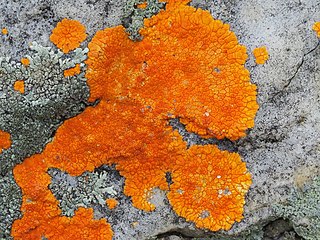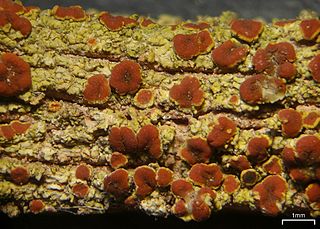
Neobrownliella is a genus of crustose lichens in the subfamily Teloschistoideae of the family Teloschistaceae. It has five species. The genus was circumscribed in 2015 by lichenologists Sergey Kondratyuk, Jack Elix, Ingvar Kärnefelt, and Arne Thell, with Neobrownliella brownlieae assigned as the type species. It is a segregate of the large genus Caloplaca. Characteristics of Neobrownliella include a thallus that is continuous or areolate, the presence of anthraquinones as lichen products, a cortical layer with a palisade paraplectenchyma, and the lack of a thick palisade cortical layer on the underside of the thalline exciple. Two species were included in the original circumscription of the genus; an additional three species were added in 2020.

Opeltia is a genus of lichen-forming fungi in the family Teloschistaceae. It has four species of corticolous (bark-dwelling), crustose lichens.
Fauriea is a genus of lichen-forming fungi in the family Teloschistaceae. The genus, which contains seven species, is a member of the subfamily Caloplacoideae.
Eilifdahlia is a genus of lichen-forming fungi in the family Teloschistaceae. It contains three species of corticolous (bark-dwelling), crustose lichens that occur in the Southern Hemisphere.
Xanthaptychia is a genus of lichen-forming fungi in the family Teloschistaceae. The genus, circumscribed in 2017, has three corticolous (bark-dwelling) species.
Franwilsia is a genus of lichen-forming fungi in the family Teloschistaceae. It has three species.
Elixjohnia bermaguiana is a species of saxicolous (rock-dwelling), crustose lichen in the family Teloschistaceae. It is found in Australia. The lichen is characterised by its varying areoles, which are thin to moderately thick, flat to slightly convex, and range from bright yellow to whitish in colour, sometimes with a greenish-yellow hue. Its apothecia are small, with a distinct orange margin and a raised brownish-orange or yellowish-brown disc.
Filsoniana australiensis is a species of saxicolous (rock-dwelling), crustose lichen in the family Teloschistaceae. It is found in Australia. The lichen forms patches up to 9 cm wide, with dull pink to brownish pink lobes and a verrucose central area. It has distinctive, raised reddish-orange apothecia.
Filsoniana kiamae is a species of saxicolous (rock-dwelling), crustose lichen in the family Teloschistaceae. It is found in Australia. The lichen forms small rosettes with brownish-orange areoles, and it occasionally develops isidia. Its rare apothecia are round, with brownish-orange margins and a reddish disc.
Filsoniana rexfilsonii is a species of saxicolous (rock-dwelling), crustose lichen in the family Teloschistaceae. Found in Australia, it was formally described as a new species in 2007. The thallus of Filsoniana rexfilsonii comprises brownish-orange squamules each hosting one to four reproductive structures.
Neobrownliella montisfracti is a species of saxicolous (rock-dwelling), crustose lichen in the family Teloschistaceae. It is found in Australia. The small lichen has dull pink to grey areoles, characterised by completely immersed, reddish to pink-brown apothecia and lacking soredia and isidia. Its areoles are closely pressed against the substrate, with the apothecia containing small, elongated ascospores and narrowly rod-shaped conidia.
Sirenophila cliffwetmorei is a species of saxicolous (rock-dwelling), crustose lichen in the family Teloschistaceae. It is found in Australia. Its thallus can reach up to 1 centimetre in width, has a whitish to whitish-grey colour, and is very thin, sometimes almost merging with the substrate, and has paler edges with a darker grey centre. Its numerous tiny apothecia give the thallus a yellow-orange appearance.
Fauriea trassii is a lichen species in the family Teloschistaceae, described in 2011. It is primarily found in the Far East of Russia, particularly in the Primorsky Krai region.
Kaernefia kaernefeltii is a species of saxicolous (rock-dwelling), crustose lichen in the family Teloschistaceae. It is widely distributed in Australia.
Oxneriopsis is a genus of lichen-forming fungi in the family Teloschistaceae. It has four species of corticolous (bark-dwelling), crustose lichens.
Lazarenkoiopsis is a single-species fungal genus in the family Teloschistaceae. It contains Lazarenkoiopsis ussuriensis, a corticolous (bark-dwelling), crustose lichen species found in the Russian Far East.
Nevilleiella is a genus of lichen-forming fungi in the subfamily Teloschistoideae of the family Teloschistaceae. It has two species of crustose lichens that are found in Australia.
Nevilleiella marchantii is a species of terricolous (ground-dwelling), crustose lichen in the family Teloschistaceae. Found in Australia, it was formally described as a new species in 2007. The thallus of Nevilleiella marchantii spreads 1–3 cm wide, with distinctive, almost spherical, pustule-like formations that give it an appearance resembling a bunch of grapes. These formations vary in shape and colour from yellow-brown to orange-brown.
Yoshimuria is a genus of lichen-forming fungi in the family Teloschistaceae. It has four species of crustose lichens.
Marchantiana occidentalis is a species of corticolous and saxicolous, crustose lichen in the family Teloschistaceae. It is found in Western Australia, usually as an inhabitant of dry twigs, bark, or wood of various plant species, but occasionally on granite rock outcrops. It forms a well-developed thallus, shiny and composed of tiny dark greenish to brown areoles, with sizes typically ranging from 5–15 mm, though larger aggregations are possible. It features numerous rounded apothecia scattered across its surface, varying in form and colour, with a distinct margin and disc.

